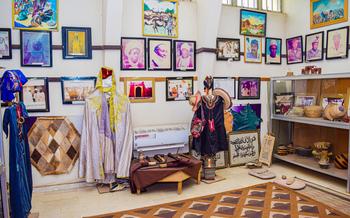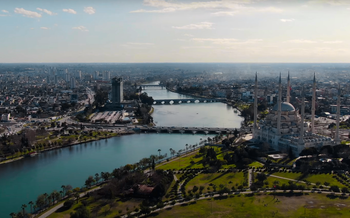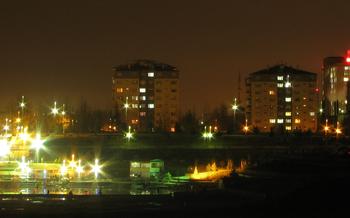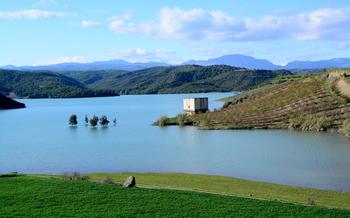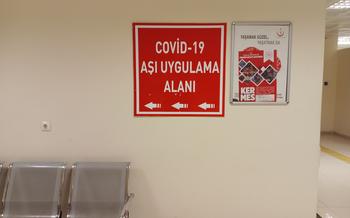
The Historical Adana Tepebag Houses
- History of Adana Tepebag Houses
- Location and Accessibility
- Architectural Features
- Cultural Significance
- Local Cuisine and Restaurants
- Shopping and Local Handicrafts
- Things to Do Nearby
- Best Time to Visit
- Opening Hours and Admission Fees
- Guided Tours and Self-Exploration
- Photography and Videography
- Accessibility for Disabled Visitors
- Local Festivals and Events:
- Accommodation and Hotels
- Insider Tip
History of Adana Tepebag Houses
Adana Tepebag Houses, nestled on a hill overlooking the Seyhan River, stand as a testament to the city's rich history and architectural heritage. Built in the late 19th and early 20th centuries, these historic houses embody the fusion of Turkish, Armenian, and French influences that shaped Adana's unique identity. Their construction marked a period of economic prosperity and cultural exchange, as the city emerged as a thriving center of trade and commerce.
Each house unfolds a story of its own, whispering tales of the families who once resided within their walls. From wealthy merchants and landowners to prominent intellectuals and artists, these dwellings served as a melting pot of diverse cultures and lifestyles. Their architectural details reflect the eclectic tastes and influences of their former occupants, creating a harmonious blend of East and West.
One captivating tale associated with the houses tells of a young woman named Aylin, whose family was forced to leave their beloved home during the tumultuous years of World War I. Decades later, as an elderly woman, Aylin returned to Adana, searching for the remnants of her childhood home. To her delight, she discovered that her family's house had been meticulously restored, preserving the memories and emotions she had long cherished.
Location and Accessibility
The Adana Tepebag Houses are nestled in the heart of the city, within easy reach of numerous attractions and landmarks. Situated on Tepebag Street, the historic district is accessible by various means of transportation. Visitors can hop on the local tram, which offers a scenic ride through the city, and alight at the Istiklal stop, just a short walk from the houses. Alternatively, taxis are readily available for hire, providing a convenient door-to-door service. For those who prefer the freedom of self-exploration, rental cars can be obtained from local agencies. If you're feeling energetic, the houses are also within walking distance of other must-see destinations, such as the Great Mosque of Adana and the Adana Ethnography Museum, making it easy to combine multiple attractions in a single day.
Insider tip: To avoid the hustle and bustle of daytime crowds, consider visiting the Adana Tepebag Houses early in the morning or late in the afternoon when the atmosphere is more tranquil, and you can savor the historic charm without distractions.
Architectural Features
The Adana Tepebag Houses stand out for their distinctive architectural style, a harmonious blend of traditional and modern elements. Each house is unique, yet they share common features that create a cohesive and visually appealing streetscape.
The wooden balconies, a prominent feature of the houses, add a touch of charm and elegance. These balconies, often adorned with intricate carvings, provide a shady spot to relax and enjoy the views of the city and the Seyhan River. The bay windows, another characteristic element, allow natural light to flood the interiors, creating a bright and airy atmosphere.
The houses also feature spacious courtyards, which serve as private outdoor spaces for residents to gather, socialize, and escape the hustle and bustle of city life. These courtyards are often decorated with colorful flowers, plants, and trees, creating a tranquil oasis in the heart of the city.
One of the most remarkable architectural details of the Adana Tepebag Houses is the intricate stonework that adorns the facades. Skilled craftsmen used various techniques to create beautiful patterns and motifs, adding a touch of artistry to the buildings. These stone carvings showcase the creativity and craftsmanship of the builders and serve as a reminder of the rich cultural heritage of Adana.
Cultural Significance
Adana Tepebag Houses stand as a testament to the city's rich history and cultural heritage. These houses have played a vital role in shaping the local traditions and way of life. In the past, they served as residences for prominent families and wealthy merchants, each leaving their unique mark on the cultural tapestry of Adana. Today, these houses continue to be revered for their historical significance and architectural charm.
One of the most notable aspects of the houses' cultural significance is their role in showcasing traditional Turkish architecture and craftsmanship. The houses' intricate facades, adorned with intricate carvings and colorful tiles, reflect the artistic prowess of the region's artisans. Visitors can wander through the houses and admire the craftsmanship that has been passed down through generations, gaining a deeper appreciation for the city's artistic heritage.
Moreover, the houses have played a significant role in fostering a sense of community and belonging among the people of Adana. In the past, the courtyards and balconies of these houses were vibrant spaces where neighbors gathered for social events, celebrations, and storytelling sessions. This tradition continues today, with many residents using the houses as community spaces for gatherings and events.
Anecdote: During my visit to Adana, I had the opportunity to attend a traditional Turkish coffee ceremony hosted in one of the Tepebag Houses. As I sat in the beautifully decorated courtyard, sipping my coffee and listening to the stories shared by the locals, I felt a profound sense of connection to the city's rich cultural heritage. It was a moment that truly captured the essence of what these houses represent: a living testament to Adana's vibrant cultural tapestry.
Local Cuisine and Restaurants
Adana is renowned for its delectable cuisine, and visitors to the city should not miss the opportunity to sample some of its local specialties. The city's culinary scene is a vibrant tapestry of flavors, colors, and aromas, with a particular emphasis on grilled meats, kebabs, and spicy dishes.
One of the most famous dishes in Adana is the Adana kebab, a long, skewered minced meat kebab that is grilled over an open fire and seasoned with a blend of local spices. The meat is tender and succulent, with a slightly crispy exterior and a burst of flavor. Another must-try dish is the şırdan, a type of offal kebab made with lamb or goat intestines, which is grilled and served with a spicy tomato sauce.
For a taste of traditional Turkish cuisine, visitors can head to one of the many restaurants located near the Adana Tepebag Houses. These restaurants offer a wide range of dishes, including meze (small plates), kebabs, soups, and desserts. Some recommended restaurants include:
- Kebapçı Ömer Usta: This restaurant is known for its delicious Adana kebabs, which are grilled to perfection and served with a variety of sides.
- Şırdancı Bedir Usta: This restaurant specializes in şırdan, and their version is considered to be one of the best in the city.
- Meşhur Adana Sofrası: This restaurant offers a wide range of traditional Turkish dishes, including kebabs, meze, and desserts.
No matter what your taste, you are sure to find something to your liking in Adana. So, come hungry and prepare to indulge in a culinary adventure that will tantalize your taste buds and leave you wanting more.
Anecdote:
During my last visit to Adana, I had the pleasure of dining at a small, family-run restaurant near the Adana Tepebag Houses. The atmosphere was warm and inviting, and the food was absolutely delicious. I started with a plate of meze, which included hummus, babaganoush, and yaprak sarma (stuffed vine leaves). For my main course, I ordered the Adana kebab, which was grilled to perfection and served with a generous portion of rice and grilled vegetables. The meat was tender and juicy, with a slightly crispy exterior and a burst of flavor. I finished my meal with a cup of Turkish coffee and a sweet baklava, which was the perfect way to end a memorable dining experience.
Shopping and Local Handicrafts
Adana, Turkey, is renowned for its vibrant shopping scene and exquisite local handicrafts. While visiting the Adana Tepebag Houses, take the opportunity to explore the nearby markets and shops for unique souvenirs and authentic Turkish products.
In the labyrinthine streets surrounding the houses, you'll find an array of traditional shops and bazaars selling a treasure trove of handmade items. From intricate carpets and kilims to colorful ceramics and gleaming copperware, there's something for every taste and budget.
One must-visit destination is the Adana Bazaar, a bustling marketplace where you can find everything from fresh produce and spices to clothing, jewelry, and antiques. Here, you'll have the chance to haggle with friendly vendors and discover one-of-a-kind items that reflect the region's rich cultural heritage.
For those seeking more contemporary shopping experiences, the modern shopping malls of Adana offer a wide selection of international brands and local boutiques. Whether you're looking for stylish clothing, electronics, or souvenirs, you're sure to find it here.
Anecdote:
During my visit to the Adana Tepebag Houses, I stumbled upon a small artisan shop tucked away in a quiet alleyway. The shop was filled with an eclectic collection of handmade crafts, including intricate wood carvings, delicate lacework, and colorful pottery. As I browsed the shelves, I struck up a conversation with the friendly shopkeeper, who shared stories about the local artisans and the techniques they used to create their masterpieces. I left the shop with a beautiful ceramic bowl, a reminder of the artistry and craftsmanship that thrives in Adana.
Things to Do Nearby
Adana Tepebag Houses are surrounded by a wealth of attractions that cater to diverse interests. History buffs can delve into the past at the nearby Adana Archaeology Museum, which houses an impressive collection of artifacts from the region's rich history. Nature enthusiasts can escape the urban hustle and bustle at the Seyhan Dam Lake National Park, where they can embark on scenic walks, enjoy picnics, or simply soak in the tranquility of the serene lake views. For a unique cultural experience, visitors can explore the vibrant Grand Bazaar, a bustling marketplace where they can haggle for traditional Turkish handicrafts, souvenirs, and delectable local delicacies.
One hidden gem worth discovering is the historic Tas Kopru (Stone Bridge), located just a short drive from Adana Tepebag Houses. This ancient bridge, built during the Roman era, spans the Seyhan River and offers breathtaking views of the surrounding landscape. Visitors can stroll along the bridge, marveling at its architectural prowess and imagining the countless travelers who have crossed it throughout history.
Whether you seek cultural immersion, outdoor adventures, or historical exploration, the vicinity of Adana Tepebag Houses offers an array of experiences that will enrich your visit to this charming city.
Best Time to Visit
The ideal time to visit Adana for a pleasant experience is during the shoulder seasons, which fall between April to May and September to October. During these months, the weather is warm and sunny, with average temperatures ranging from 15 to 25 degrees Celsius (59 to 77 degrees Fahrenheit). The crowds are also smaller, allowing for a more relaxed and intimate visit to the Adana Tepebag Houses.
To avoid the peak tourist season and enjoy a more tranquil atmosphere, it's best to steer clear of the summer months, particularly July and August, when temperatures can soar and the city can be bustling with tourists. If you're flexible with your travel dates, consider visiting during the shoulder seasons or even in the winter months, when the weather is cooler but still pleasant.
Here's a story to illustrate the benefits of visiting during the shoulder season:
During a trip to Adana in May, I had the opportunity to explore the Adana Tepebag Houses without the throngs of tourists that typically descend upon the city in the summer. The weather was perfect for leisurely walks through the neighborhood, allowing me to fully appreciate the intricate details of the houses and soak in their historical charm. I could take my time wandering through the narrow streets, capturing stunning photos without having to wait for crowds to clear. It was a truly immersive and enjoyable experience.
Opening Hours and Admission Fees
The Adana Tepebag Houses are open to the public daily from 8:00 AM to 5:00 PM, providing ample time for visitors to explore the beautiful architecture and learn about the history of these historic homes. The entrance fee is a modest 5 Turkish Liras (TRY) per person, making it an affordable attraction for both locals and tourists.
For those seeking a more in-depth understanding of the houses and their significance, guided tours are available for a small additional fee. These tours are led by knowledgeable guides who provide fascinating insights into the history, architecture, and cultural importance of the Adana Tepebag Houses.
Insider tip: To avoid the crowds and have a more relaxed visit, consider visiting the houses during the off-season (November to March). During this time, you'll have the opportunity to explore the houses at your own pace and take in the tranquil atmosphere without the hustle and bustle of peak tourist season.
Guided Tours and Self-Exploration
Adana Tepebağ Houses offer both guided tours and the option for self-exploration, catering to different preferences and interests. Guided tours are an excellent way to gain in-depth historical insights and anecdotes about the houses. Knowledgeable guides share stories and facts that bring the history of these homes to life. Visitors can ask questions and engage in discussions, making the experience more interactive and enriching.
For those who prefer a more independent exploration, self-guided tours allow visitors to wander through the houses at their own pace. This option provides the freedom to explore every nook and cranny, take photos, and soak in the atmosphere without being tied to a group. Visitors can follow the provided maps or simply wander aimlessly, discovering hidden details and unique perspectives.
Anecdote:
During my visit to Adana Tepebağ Houses, I opted for a guided tour. Our guide, a passionate historian, captivated us with tales of the families who once lived in these homes. He pointed out architectural details that I would have missed on my own, and his storytelling brought the history of the houses to life. It was a truly immersive experience that left me with a deeper appreciation for these centuries-old structures.
Photography and Videography
Capturing the beauty and essence of Adana Tepebag Houses through photography or videography is a delightful experience. As you wander through the historic streets, you'll find countless photo opportunities that showcase the architectural details, vibrant colors, and unique atmosphere of the neighborhood.
For the best photography results, try to visit during the golden hours of sunrise or sunset when the soft, warm light casts a magical glow over the houses. Experiment with different angles and perspectives to capture the intricate carvings on the wooden balconies, the charming bay windows, and the lush courtyards. If you're using a tripod, set it up in strategic locations to achieve steady shots and avoid blurry images.
Drones are not permitted within the Adana Tepebag Houses area due to safety and privacy concerns. However, you can still capture stunning aerial shots from nearby vantage points, such as the hilltop park overlooking the neighborhood.
One memorable moment I experienced was during a photography session early one morning. As the sun peeked over the horizon, casting a warm glow over the houses, I captured a breathtaking shot of a family enjoying breakfast on their balcony, surrounded by vibrant flowers and the sound of birdsong. It was a perfect moment that encapsulated the charm and tranquility of Adana Tepebag Houses.
Accessibility for Disabled Visitors
Adana Tepebag Houses strive to ensure inclusivity and accessibility for all visitors. Wheelchair access and ramps are available throughout the houses, enabling visitors with mobility challenges to navigate the premises smoothly. Additionally, accessible tours or guides can be arranged upon request to provide a more comprehensive and inclusive experience. It's recommended to contact the site in advance to inform them of any specific accessibility needs, allowing them to make necessary arrangements for a seamless and enjoyable visit.
Local Festivals and Events:
Adana is a vibrant city that celebrates its rich culture and traditions through various festivals and events throughout the year. One of the most notable events is the Adana International Film Festival, held annually in September. This prestigious festival showcases a diverse selection of local and international films, attracting filmmakers, movie enthusiasts, and celebrities from around the world.
Another popular event is the Adana Orange Blossom Festival, held in April or May when the city's orange groves are in full bloom. This festival celebrates the region's renowned citrus fruits and features parades, traditional music and dance performances, and exhibitions of local products.
For those interested in history and culture, the Adana Archaeology Museum hosts regular events and exhibitions showcasing the city's rich history and archaeological discoveries.
Insider Tip: To truly immerse yourself in the local culture, plan your visit to Adana during one of these festivals or events. You'll have the opportunity to experience the city's vibrant energy, meet friendly locals, and create lasting memories.
Accommodation and Hotels
When exploring the historical Adana Tepebag Houses, finding a convenient and comfortable place to stay is essential. Several hotels and guesthouses are located within walking distance of the houses, offering a range of options to suit different budgets and preferences.
For a luxurious experience, the Divan Adana Hotel is a top choice. Located just a few steps from the houses, this 5-star hotel offers elegant rooms, a rooftop pool, and panoramic views of the city.
If you prefer a more budget-friendly option, the Adana Oteli is a great choice. Situated a short walk from the houses, this cozy hotel offers comfortable rooms at an affordable price.
For those seeking a unique and authentic experience, the Adana Evleri Butik Otel is an excellent option. This charming hotel is housed in a restored historical building and offers a glimpse into the city's past.
When choosing your accommodation, it's always a good idea to book in advance, especially during peak tourist season. This will ensure that you have a place to stay and avoid any last-minute surprises.
Insider Tip
For a truly unforgettable experience, consider staying at the historical Tepebağ Evleri Konaklama. This unique hotel is housed within the Adana Tepebag Houses themselves, offering guests a chance to immerse themselves in the history and charm of these iconic structures.
The hotel offers a variety of rooms, from cozy doubles to spacious suites, all decorated in a traditional Turkish style. Guests can enjoy a delicious breakfast each morning in the courtyard, surrounded by the beautiful architecture of the houses.
Staying at the Tepebağ Evleri Konaklama is an excellent way to experience the true essence of Adana and to make your visit to the Adana Tepebag Houses truly memorable.
